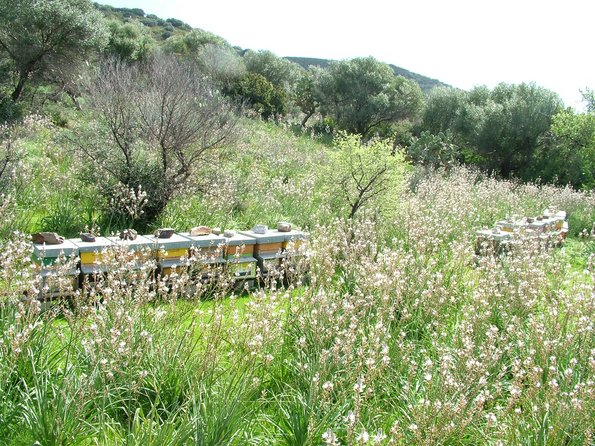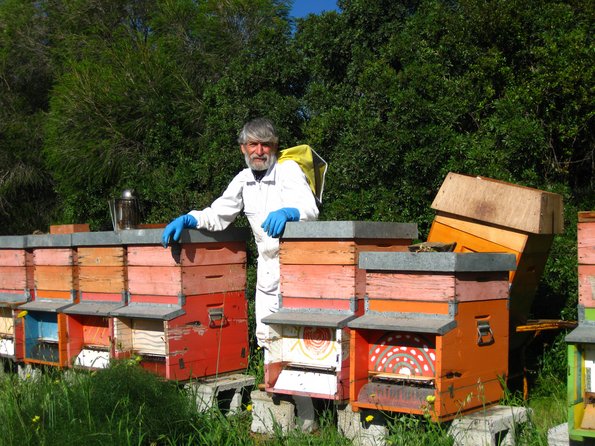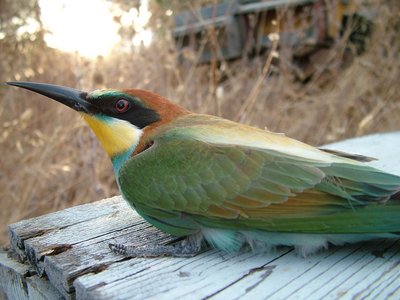Southern bees are very industrious!
The maquis – a year-round eldorado of natural bee plants
by Heini Hofmann
Stereotypes divide the work ethic into a North-South divide – from workaholic to siesta artist. Do such nuances also exist in animals? We wanted to know and put it to the test. The result is astonishing!
We chose the miniature farm animal that is said to be extremely hard-working – the honeybee, our embodiment of industriousness. “The bee is a very hard-working creature,” say the British. We compared the bees in our latitude with those in southern Sardinia, from a beekeeper in southern Sardinia we discovered that there is – due to nature – a reciprocal south-north divide in the industriousness of the bee.
Two working worlds
In Central and Northern Europe, honeybees are busy workers under royal supervision. During the warm season where they collect nectar and pollen. In the other half of the year, when cold or even snow make this impossible, our bee colonies, huddle closely together in the form of a cluster and go rest for the winter (not hibernation) for months.
Their southern counterparts can only dream of this; because here, natural bee plants bloom all year round. Snow is (almost always) a foreign word. This means that they work for twelve months straight, without days off or even siesta – a supra-animal performance. Even human workaholics can’t keep up.
Together with his wife Fiorella Di Luca, beekeeper Luigi Deiana runs a self-established apiary in the province of Sarrabus in south-eastern Sardinia, on the banks of the river Uri, north-west of San Vito, in the midst of typical macchia (French: maquis), a low, evergreen shrub formation of Mediterranean hills close to the coast. He came across beekeeping by chance when he worked as a machinist and technical draughtsman in Germany and saw a beekeeping film on television. That was his key experience.
From the grassroots
Back in Sardinia, he bought a piece of Macchia land and worked as a day labourer to realise his dream of becoming a professional beekeeper – through self-study and “learning by doing”.
He started with four bee colonies – and failed at first. But his will to persevere was great. and he was able to establish 20 colonies. In 1982, with the support of the region, he acquired 50 more – and from then on he was a dyed in the wool professional beekeeper.
While there are four bee breeds in Switzerland (the dark landrace Mellifica, the grey bee Carnica, the southern Ligustica and the Eurasian Caucasica), there is only one breed in Sardinia, the Mediterranean Ligustica with the typical yellow abdominal rings, which is the most represented breed in the world today.
In Sardinia (as in Switzerland) the Dadant housing system is common, with free-standing, side-by-side individual boxes, which can be extended as desired depending on the growth of the colonies. After the lid has been removed, work is accessed from above and not from behind, as is the case with the German-Swiss system, where the boxes are permanently installed in the apiary.
All-year-round natural bee plants
While in our latitudes the honey harvest happens only once a year, in southern climes something is always in bloom and the honey harvest is spread throughout the entire year, – from January to December. And important to note is that these are only wild plants. The traditional mixed honey of different flowers is the main crop in spring (end of April/beginning of May).
Over the span of a year, the single-flower honeys come into play – in spring from asphodel (lily plant) to lavender (crested lavender) and citrus blossoms to rosemary. In summer there is eucalyptus honey and mixed honey from blackberry, thistle, mullein and prickly pear. In autumn there is a special honey from the carob tree and in winter (December/January, but not always) the so-called bitter honey from the strawberry tree.
In order to make the best use of these seasonal and local sources of honey, the beekeeper moves his Dadant hives to the region where most natural bee plants bloom – just as our migratory beekeepers do with mobile apiaries in various mountainous cantons.
Five times more honey
The bees’ liquid raw material to produce blossom honey is the sugary blossom sap nectar, a secretion of the nectarines, the honey glands of the blossoms, which the bees transport in the honey stomach. (Forest honey from honeydew, produced by aphids, does not exist in the low-growing Sardinian maquis). Pollen, on the other hand, i.e. pollen that serves as food for the brood”.
While in Switzerland around ten kilos of honey per bee colony per year is the norm (with large fluctuations depending on the weather), beekeepers can harvest around five times as much honey in the Sardinian maquis with its year-round abundance of flowers.
Sardinian honey is considered particularly delicate because the maquis is an ideal bee pasture. Honey, almonds and nuts are the basic ingredients of many Sardinian sweets. Honey is also an incomparable source of energy, since it has five times as many calories as milk, three times as many as meat and twice as many as eggs.
Problems in Paradise
In short, the conditions in the flower-rich Sardinian Macchia landscape would be paradisiacal for the bees and for the beekeeper with his manageable family business (today a good 80 people). But there is a problem: at the beginning of the eighties of the last century, varroasis (a mite disease of honeybees) was detected for the first time in Sardinia, which had been brought to Europe from the Urals at the beginning of the seventies.
Varroa mites would never have made it to Sardinia on their own if they had not been introduced by large-scale beekeepers from the Italian mainland who came to the island as migratory beekeepers with contaminated colonies. But how can one treat a sick bee colony that does not take a winter break like ours, when there is a variety of hives all year round and thus uninterrupted collecting activity and brood care?
Varroa control is not possible during brood activity. There is only one trick that helps (unfortunately necessary, but not very pleasant): one is forced to lock up the queen for some time in summer so that she does not lay any more eggs and so there is no capped brood for a few days, which then makes oxalic acid treatment possible in this time window. Another complication for beekeepers in the south is the beautiful but unfortunately voracious bee-eater (see box).
In harmony with nature
You can sense beekeeper Luigi Deiana’s great affinity with nature; his workplace is the wild, deserted Macchia landscape. He knows that he must not place his beehives in shady places and that he must work calmly with his Ligustica bees, because they are gentle by nature, not aggressive and hard-working. “Bad bees”, he is convinced, “are also a question of the beekeeper and his handling of these miniature creatures.”
How he handles the gifts of nature with care is also shown by the fact that when he sells his natural products, he does not speak of his customers, but of his friends. His principle is direct sales in his own small business, where his wife Fiorella processes the products, and sells the products at the village markets (where we, too, made our first acquaintance with him in Villasimius).
He also sells by mail order, mainly to the Italian mainland. But here, too, there is a small, likeable difference: he does not sell his bee products by the bucket to wholesalers, as large beekeepers do, but in small containers to his trusted customers. His greatest wish is that his children will one day continue what he has built up. It was not only the southern bees that impressed us – their beekeeper did too. •
Problem Bee-eater
HH. It is one of the most colourful birds in the world and feeds mainly on bees, wasps and bumblebees – the maroon and blue-green coloured bee-eater (Merops apiaster) with a yellow throat. Typical features are the long, pointed and slightly downward curved bill, the long arrow wings and the short legs (clearly visible in the picture). It preys on insects in swallow-like flight. Bee-eaters are social birds and usually breed in colonies. They migrate to Sardinia from their wintering grounds in Africa in mid-April and return in mid-September.
They are a real problem for beekeepers, and because they are protected, they cannot be controlled. Stomach examinations of dead bee-eaters revealed the remains of up to thirty bees. Beekeeper Luigi Deiana speaks from experience: “When the birds appear, fear spreads in the bee colonies, the workers hardly dare to fly out. Queens are particularly at risk because they fly more slowly due to their size. But a queen less colony is doomed.”
In Switzerland, however, the bee-eater is not a threat to beekeeping (for the time being). The first brood occurred in 1991, but it was not until 2017 that the number of breeding pairs exceeded one hundred. However, this trend is likely to increase as the climate warms.


